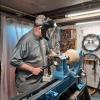Thought I was going to get a spalted maple sphere out of the blank I started with but ended up with just a plain
nondescript round piece of nothing special. Decided to try and jazz it up with some coloring. Wasn't looking to create
a great piece, more of just experimenting with colors and design. Used Tombow & Staedtler pens and although they look
okay while the piece is turning once you stop the lathe the colors aren't nearly as bright. Guess I'm looking for a
higher gloss like a Krylon paint would give you except in pen form. Anyone have a suggestion???
Tried out a Copic Multiliner SP with a 0.1 tip for the squiggly lines & decoration and must say I was impressed with the lines it gave me.
Nice thin bright black line every time.
Unless I figure out how to get a much brighter coloring, I'll probably just do some eccentric slashing & hollow/pierce for embellishing these spheres.
Maple Sphere 8.jpgMaple Sphere 5.jpg





 Reply With Quote
Reply With Quote


